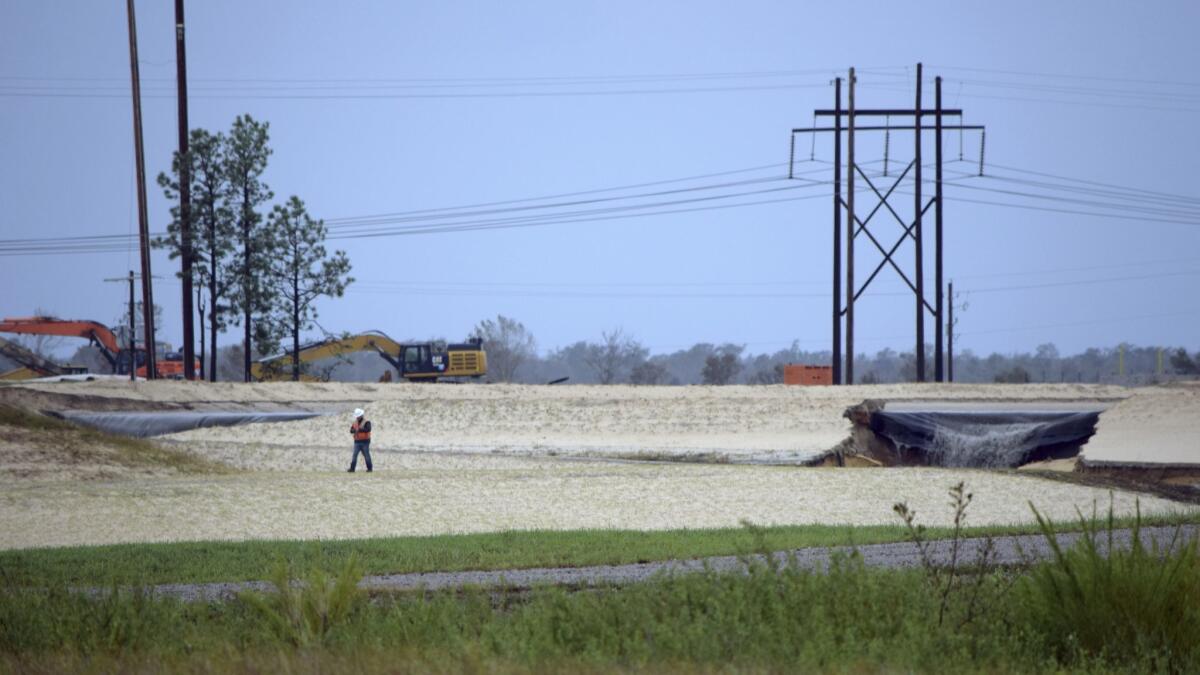Floodwaters inundate lake at North Carolina power plant, raising alarm

Duke Energy activated a high-level emergency alert at a retired coal-fired power plant in North Carolina as floodwaters from the Cape Fear River overtopped an earthen dike at the facility and inundated a large lake, raising concerns of a potential breach.
The dam containing Sutton Lake appeared stable and Duke officials were monitoring it with helicopters and drones, Duke spokeswoman Paige Sheehan said Thursday, adding that it was “an evolving situation.”
Company employees notified state regulators overnight that the 1,100-acre lake at the L.V. Sutton Power Station near Wilmington was at the highest level of alert under its emergency action plan.
A copy of that plan reviewed by the Associated Press defines an Emergency Level 1 event as: “Urgent! Dam failure is imminent or in progress.”
“Flash flooding will occur downstream of the dam,” the manual says. “This situation is also applicable when flow through the earth spillway is causing downstream flooding of people and roads.”
Sheehan described that language as “a worst-case scenario to allow everyone to prepare accordingly.” She said the company was in touch with local emergency management officials, but the high water levels meant “if the berm were to break there would be very minimal impact downriver.”
The reservoir is a former cooling pond for the Sutton power plant and is adjacent to three large coal-ash dumps. The coal-fired plant was retired in 2013 and replaced with a new generating station that runs off of natural gas.
A landfill that was under construction at the site ruptured over the weekend, spilling enough material to fill 180 dump trucks. Coal ash contains arsenic, mercury and other toxic metals.
Sheehan said the company does not believe any coal ash is at risk of spilling from the site amid the current flooding, as work continues to clean up the earlier spill. The site has received more than 30 inches of rainfall as a result of former Hurricane Florence, with the Cape Fear River expected to crest on Saturday.
State inspectors were able to make it to Sutton on Tuesday and to collect samples from the area around the breached coal-ash landfill. Sutton Lake is used for public recreation, including fishing and boating.
Duke Energy said Wednesday that water samples collected by its employees and tested at the company’s own lab showed “no evidence of a coal ash impact” to Sutton Lake or the Cape Fear River.
Those results, provided to the AP, did detect chemicals that are present in coal ash in wetlands immediately adjacent to the shoreline. And they show that the employees collected their samples for Sutton Lake on the opposite side of the reservoir from the affected wetlands.
State regulators were awaiting the results of their own testing before determining whether there were any violations of clean-water-quality rules, said Megan Thorpe, a spokeswoman for the state environmental agency.
Duke’s handling of its ash waste has faced intense scrutiny since a drainage pipe collapsed under a waste pit at an old plant in Eden in 2014, triggering a massive spill that coated 70 miles of the Dan River in gray sludge. The utility later agreed to plead guilty to nine Clean Water Act violations and pay $102 million in fines and restitution for illegally discharging pollution from ash dumps at five North Carolina power plants. It plans to close all its ash dumps by 2029.
At the H.F. Lee Power Plant near Goldsboro on Thursday, three old coal-ash dumps capped with soil were underwater after flooding from the Neuse River.
Staff from the Waterkeeper Alliance, an environmental advocacy group, visited the site by boat on Wednesday and took photographs and collected samples of gray-colored sludge and water that they said was washing off into the floodwaters. The group said the samples would be analyzed by a private lab to determine whether the gray muck contained coal ash.
Sheehan said Thursday that Duke was monitoring the site and that any release of coal ash appeared “minimal.”
“We’ll learn more as floodwater recedes,” she said.
More to Read
Sign up for Essential California
The most important California stories and recommendations in your inbox every morning.
You may occasionally receive promotional content from the Los Angeles Times.









